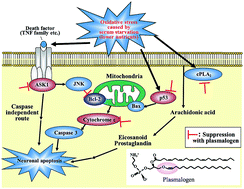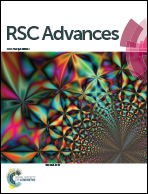Extrinsic plasmalogens suppress neuronal apoptosis in mouse neuroblastoma Neuro-2A cells: importance of plasmalogen molecular species†
Abstract
The level of ethanolamine plasmalogen (Pls), a phospholipid with antioxidant activity, is known to decrease in the brains of patients suffering from Alzheimer's disease (AD). The present study was performed to determine the mechanism underlying the neuroprotective effect of Pls. Neuronal apoptosis induced by serum starvation was suppressed by Pls in a concentration-dependent manner. Pls also induced the suppression of p53 and cytochrome c expression, which was increased due to serum starvation. Further, the activation of apoptosis signal-regulating kinase 1 (ASK 1) was also inhibited by Pls. Among the phospholipids analyzed, only Pls displayed an antiapoptotic effect. Pls also inhibited the reduction of cellular phospholipid and 20:4 levels. These functions underlying the action of Pls may be responsible for the regulation of membrane functions and second messenger production. In addition, of the species investigated, Pls with 22:6 (DHA) displayed the strongest suppression of neuronal apoptosis; however, no significant differences in reactive oxygen species (ROS) scavenging activity was observed between various species of Pls. Overall, our results show the potential of Pls, especially those containing DHA, in the prevention of AD.

- This article is part of the themed collection: Towards understanding and treating Alzheimer’s disease

 Please wait while we load your content...
Please wait while we load your content...